#out here trying to win cinematography emmys for a making of feature
Explore tagged Tumblr posts
Text






KATHRYN HAHN in Marvel Studios' Assembled: The Making of Agatha All Along
#repeating gifs on multiple posts because i can't get over them#out here trying to win cinematography emmys for a making of feature#the making of#agatha all along#kathryn hahn#agatha harkness
812 notes
·
View notes
Link
Congratulations to Adriano Goldman , ASC, BSC, ABC, Director Of Photography, for his Creative Arts Emmy win OUTSTANDING CINEMATOGRAPHY FOR A SINGLE-CAMERA SERIES (ONE HOUR) for season 4 episode 3 ‘Fairytale’ on September 11, 2021. Here are his insights on filming the episode with director Benjamin Caron.
‘The Crown’ Used Lighting and Composition to Trap Its Characters Inside a ‘Fairytale’
Director Benjamin Caron and cinematographer Adriano Goldman discuss how they destroyed Diana and Charles’ marriage before it even began.

Behind the Scenes of “The Crown” Season 4, Episode 3 Photo: Netflix
Over “The Crown’s” four seasons, the halls of Buckingham Palace have become familiar visual signifiers for both the grandeur and the pressure placed upon the royal family. But in the third episode of this most recent season, “Fairytale,” cinematographer Adriano Goldman and director Benjamin Caron stretched the limits of the show’s visual language to create — and then to destroy — Princess Diana’s (Emma Corrin) fairytale fantasies.
Much of the episode is given over to Diana slowly realizing that, like many princesses stuck in a castle before her, she has fallen into a trap. But Goldman and Caron opened up the ways they shoot their Buckingham Palace sets to show how the demands of the Crown consume everyone on the eve of the fateful marriage.
They force the jaws of the trap open wide with a pre-credits sequence of Diana’s night out with her friends after Charles (Josh O’Connor) proposes to her. The scene is a departure in every sense, not just to the swank ’80s members’ club that Diana frequents.
“You try to deliver something that is more romantic, a little bit more colorful, fun to start,” Goldman said of the sequence in an interview with IndieWire. “We wanted to not change the style too much, but there should be a transition from a very colorful pre-title sequence, a very interesting and more romantic beginning.”
That romance is on full display, most noticeably in the brighter, guadier colors of the club and much warmer tones of Diana’s Earl’s Court flat. But Goldman’s camera also interposes itself almost as a fourth (slightly intoxicated) friend, swinging around inside the girls’ cab to get a look at both Diana and Buckingham Palace, or flinging itself down onto the bed with the girls at the end of the night. The look of the sequence stands in contrast to the stately shots and slow tracks which are the show’s normal rhythm for everyone in the royal family. Well, for everyone in the royal family except maybe Princess Margaret (Helena Bonham-Carter), who gets to dance by a pool every now and again.
“We really considered how we could reverse [that fairytale opening] and be very present with her, and [how we could] make her feel young, actually. Part of this is she’s a young girl going into the palace,” Caron said.
Caron and Goldman gave the audience several visual signifiers that are easy to clock in this sequence, as well as Diana’s goodbyes to her friends that follows: the gold and neon hues of the night out, the warm, eye-level close-ups of Diana dancing in the club, and a signature spiral staircase Diana descends to begin her life as a princess.
Over the course of the episode, these colors will fade. The close-ups inch slightly above Diana’s eyeline, so that it feels like the camera, along with the rest of the Royals, is looking down on her. And when a spiral staircase reappears, it will lead to Diana’s lowest point.

“The Crown” Season 4, Ep. 3 “The Fairytale” Screenshot
With Diana ushered inside Buckingham Palace to shield her from the press in the run-up to her and Charles’ wedding, Caron and Goldman emphasized how small and vulnerable Diana looks inside the palace walls. The opening of “Fairytale” had a long shot of the club, and Diana fit snugly within it. Once inside Buckingham Palace, the negative space often overwhelms Diana, and the camera backs away to show just how alone she truly is, perhaps best exemplified in the scene of her grandmother (Georgie Glen) physically tying her up while instructing her in how to speak like a royal.
Caron and Goldman deliberately call back to the romance of the opening to twist the knife, having Diana dance ballet inside the palace and then try to break out of the regimented structure of it as the pressure on her mounts. “I remember sort of holding the frame and I remember the camera operator was trying to follow us, but [I said no,] just hold the frame static and let her move in and around it,” Caron said. “So it really felt like someone trying to break out [of] somewhere.”
But of course, the camera never does let her leave the frame. Unlike the quick, fun cuts of Diana dancing in the club, there is no pressure release here. There is nowhere for Diana to go.
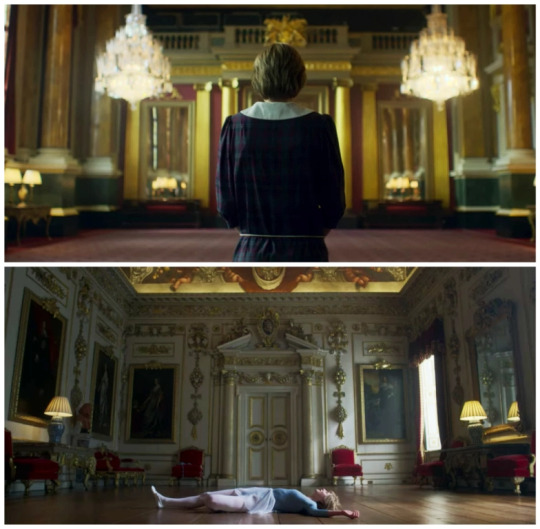
“The Crown” Season 4, Ep. 3 “The Fairytale” Screenshot
Caron wanted to use visual features that would feel right at home in a Disney princess story to their most punishing effect and perhaps the most powerful one of these motifs reoccurs when “The Crown” has Diana descend another spiral staircase. “[Ben] was very specific about this spiral because she’s going down on a spiral emotionally,” Goldman said of the shot that leads Diana down to the kitchen, a moment of late night desperation that kicks off her eating disorder. “He didn’t want to follow her on the steps, like on a steadicam. He wanted [the camera to be] facing down and going down with her to the very bottom of her feelings and her emotions.”
Caron described it as going to the “bottom of a well,” once Diana enters the kitchens and becomes enveloped in darkness — except for the fluorescent blues of the refrigerator lights, which makes the space feel like a morgue. This strong use of color, like all the changes in the episode, is grounded in the reality of whatever space Diana finds herself in. But the emotion and, indeed, the foreshadowing that Caron and Goldman are able to imbue those spaces with give Diana’s spiral real visual potency and a visceral sadness.

“The Crown” Season 4, Ep. 3 “The Fairytale” Screenshot
What is so thrilling about “Fairytale” is that it spares no one. Two striking scenes toward the end of the episode don’t have Diana in them at all, and yet push the series’ visual language to show how the palace and this marriage will swallow the characters who have been there all along.
In the first of these, Margaret tries to persuade Elizabeth, the Queen Mother (Marion Bailey), and Philip (Tobias Menzies) to call off the wedding. Caron wanted the scene to have a “conspiratorial, almost a Jacobian feel” to highlight the cold, businesslike calculations these four people are making for the happiness of two others.
“I remember saying to Adriano,’no no no, let’s go darker,” Caron said of this sequence and the next one. Goldman also recalled the desire to push the scene even further visually, lighting characters at harsh, dynamic angles or in almost complete shadow, so that the scene would feel spiritually closer to “The Godfather” than to the show’s usual style. The comparison is apt, given the mahogany browns and greens of the sitting room and the firelight that Goldman and Caron used to emphasize shadows falling into the crags on the characters’ faces. Vito Corleone could easily be sitting in a corner of one of those frames.
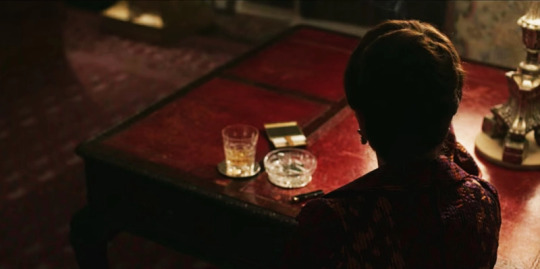
“The Crown” Season 4, Ep. 3 “The Fairytale” Screenshot
The next scene — when Elizabeth goes to find Charles and offer him a final few words on his marriage — Caron and Goldman viewed as a way to visually crystalize their relationship and how it is marred by their obligations to the monarchy. “Wouldn’t it be painful if you had Charles looking out the window and he felt the reflections of the fireworks and the noise and the celebrations outside?” Caron said about how he started conceiving of the blocking and framing of the exchange between mother and son. Each cinematic choice builds from a sense of what would be more painful, what would put more strain on the relationship.

“The Crown” Season 4, Ep. 3 “The Fairytale” Screenshot
The filmmakers created this visual strain between Queen and Crown Prince not just by keeping them at opposite sides in the composition, but by keeping one of the pair always just out of focus in the shots with the two of them — they can’t even occupy the same level of detail in the frame. Color plays a role, too, with bright blues and reds from the fireworks, reflections of the Union Jack, always being part of the light through which the audience sees the resigned sadness on Colman’s face and the abject misery on O’Connor’s. Goldman said this is the scene where he realizes he will never escape the system of the monarchy. “He realizes it’s too late. It’s a trap. He’s been trapped.”
“It always comes back to the Crown,” Caron said, and it is really from the perspective of the Crown itself that we watch the characters prepare to head to church on the day of the wedding. When the audience finally sees Diana in her dress, she faces away from the camera and moves into that oppressive cavernous space which has put so much pressure on her throughout the episode. It’s a slow, almost funereal march toward the fate the audience already knows awaits her. Charles, on the other hand, gets the close-up this time. But the camera, with equal grimness, tracks slightly down and in, so that his face begins to loom over the frame, making him look monstrous.
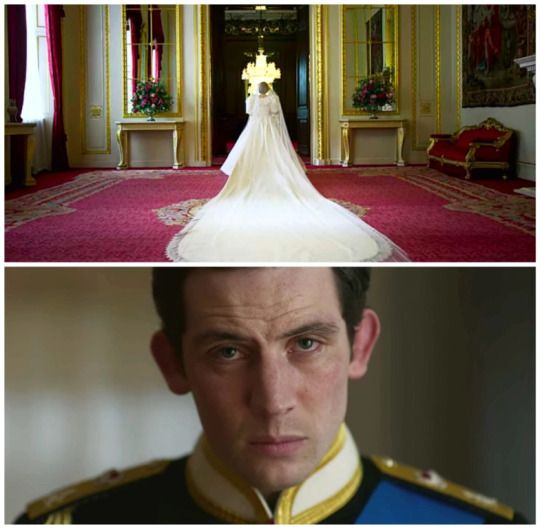
“The Crown” Season 4, Ep. 3 “The Fairytale” Screenshot
Of course by now, the visual choices that Caron and Goldman made for “Fairytale” have taught the viewer that there is another monster, a much more powerful one, looming over the episode’s final frame: The Crown is the monster that always gets you in the end.
#emma corrin#josh o'connor#princess diana#the crown netflix#the crown#emmy awards 2021#cinematography#adriano goldman#the crown season 4#thecrownnet
39 notes
·
View notes
Link
I think I've figured it out. If "Lois & Clark" was "Moonlighting" with super-powers, "Smallville" was "Dawson's Creek" with superpowers, and "Supergirl" started as "The Devil Wears Prada" with superpowers, then "Superman & Lois" is "This Is Us" with superpowers.
Spoilers ahead!
That may not be entirely accurate—I've watched maybe 15 minutes of "This Is Us"—but I feel like that's the kind of tone this show is going for, the family-centered melodrama. The kind of show that would be designed to manipulate emotions and win Emmies if it didn't occasionally feature CGI battles between Superman and an alternate-universe Lex Luthor. I thought after the pilot that the muted color palette was an attempt to visually echo the Snyder movies—and that may be a piece of it—but it also reminds me of every clip I've seen of that show where the guy from "Heroes" gets killed by a pressure cooker.
The result is a show that isn't quite like any of the other superhero shows on The CW. The closest (of the ones I've watched) is "Black Lightning," which similarly was about an older hero trying to raise a family, but even that felt more like "The Flash" in terms of cinematography and structure. You still had the Hero being directed by the Guy In The Chair to face a particular threat. Superman doesn't have the same support network, or the same relationship with his kids and the problem of adolescent superpowers.
I continue to be cautiously optimistic about this series after episode two. I can see where some of the plots could easily go sideways, and the decision to cast two black male actors as two of our antagonists when the rest of our principal cast is pretty lily-white is Not Great, but right now I'm interested in seeing how things go, and I don't really understand where some of the vitriolic fan response is coming from. At worst this show is fine.
There's a lot I like here. Every character's core conflicts internally and externally are already built at this point, and there are good points of conflict and connection between most of our main cast members.
It would be easy to fall into the trap where Clark can't do anything right as a parent—which seemed to be the direction they were going in the pilot—but it's clear here that he's doing his best, and that leads to good moments with the kids.
It's nice to see that the relationship between Clark and Sam Lane isn't all sunshine and roses; they have reason to distrust one another, and while they both clearly think they're doing the right things to keep their family safe, they have very different ideas about how to do that. It's also interesting that they're bringing in Project 7734, which I think first appeared in the World of New Krypton story.
It's interesting that the trend has been to show Jor-El with a beard since...at least Superman: Secret Origin, but maybe as far back as the Richard Donner run on Action or "Up, Up, and Away."
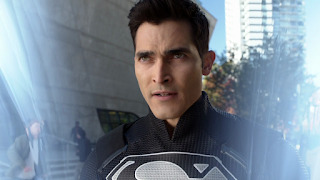
After years of seeing evil/corrupted/morally-ambiguous versions of Superman in the comics and prominent adaptations and pastiches—including the Injustice games, which we saw Jordan playing in the pilot—it's kind of a stroke of brilliance to make the main supervillain of this piece a version of Luthor from a world where Luthor was right and Superman was bad or went that way. It may be petty of me to appreciate that the evil Superman is wearing a black costume as in some prominent scenes by that one director with a New 52-style high collar (even if it looks to be the same costume that the evil Superman wore in the "Elseworlds" crossover a couple years back), but I'm embracing it. It's a good, simple visual shorthand.
Speaking of costumes, I think it's interesting how much Hoechlin's main Superman costume for this series looks like the costume from the Smallville Season 11 comic and Superman: Earth One, down to the two-toned blue areas.
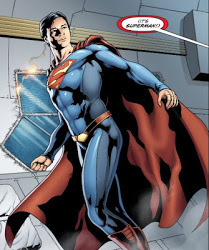
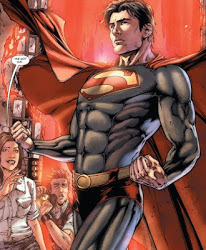
It even has the same belt as that Smallville costume. Of the three main suits Hoechlin has worn—the one on "Supergirl," the Fleischer-inspired one in the pilot opening, and this main one—this is easily my least favorite; the muscles feel padded or painted-on (which is understandable; that visible eight-pack abs physique may be sustainable for a few weeks of film shooting, but not for the months needed to film a season of television), and it just feels more muted than even the darker blue of the "Supergirl" costume. But it's not bad, and making the belt red and yellow helps make up for the lack of trunks, and the two blue shades are one solution to the endless field of blue that most trunk-less versions of the costumes have.
It's nice that every character has a clear arc ahead of them, and I do hope that (especially since her name's in the title) Lois's story gets increasing focus over the season, despite what we've heard from the writers' room. It's one of the plots that I can see going sideways—the Big City Reporter coming in to keep the Backwards Hicks from acting against their own interests, or learning that maybe her Big City Liberal Ways just don't work in the simple lives of Rural Americans—but I feel like the way things are set up now shows a degree of awareness that might avoid those pitfalls. We see complications to the "life in Smallville is simpler" mantra here—Sam Lane rejects it outright—and Morgan Edge is a prime indication of the fact that the same problems are at play in both the big cities and rural towns.
I've lived in rural farm towns for most of my adult life. I've seen towns try to out-bid each other with municipality-killing tax breaks over businesses as small as local car dealerships, let alone big billionaires with promises of better jobs. I've had conversations with people who think the unions just have too much power these days and the owner takes all the risk so he should be able to take all the profits too. A show that's going to champion the need for independent local press when conglomerates are buying up papers and stations around the countries, that's going to argue that accepting scraps from billionaires because you're desperate is tantamount to extortion, that's a show that speaks to me, at least, and hopefully speaks to some people who might otherwise be hostile to those kinds of political messages.
It is weird that Edge is interested in Smallville's mines rather than, you know, its farms, but I can see some logic behind that story decision. I do wonder if it's going to tie into some of Edge's more comic book-style motivations. Is there Apokoliptian tech in these mines? Kryptonite? Who knows?
Overall, I think this is a pretty strong start. It's not perfect, and I honestly wish the tone were a little closer to some of the other CW superhero shows, but I understand why they'd try to distinguish themselves from the pack. I'm invested in the characters, and I'm interested to see where the story goes. I realize that I'm a cheap date when it comes to Superman adaptations, but so far I'm enjoying this one more than most.
1 note
·
View note